Abstract
To determine the importance of specific capsule type in the pathogenesis of invasive Haemophilus influenzae disease, we compared the virulence of type b and type d strains isolated from different children with the virulence of transformation-derived type b and type d organisms. In addition, the unencapsulated derivative of these strains was also examined. Virulence was assessed by determining the ability of the strains to produce bacteremia with intranasal or subcutaneous inoculation. Unencapsulated derivatives were unable to cause bacteremia by any route; all type b strains (whether natural or derived by transformation), a natural type d, and a type d derived by transformation were able to produce bacteremia with similar frequency (42 to 62%) when 10(7) colony-forming units was given intranasally. Subcutaneous inoculation of 10(3) colony-forming units of strains with the type b capsule produced bacteremia at a greater frequency than did the strains with the type d capsule (P less than 0.002). The type d isolate was more virulent than a mutagenized derivative of the strain. We conclude that the type b strains are more virulent than type d when inoculated subcutaneously.
Full text
PDF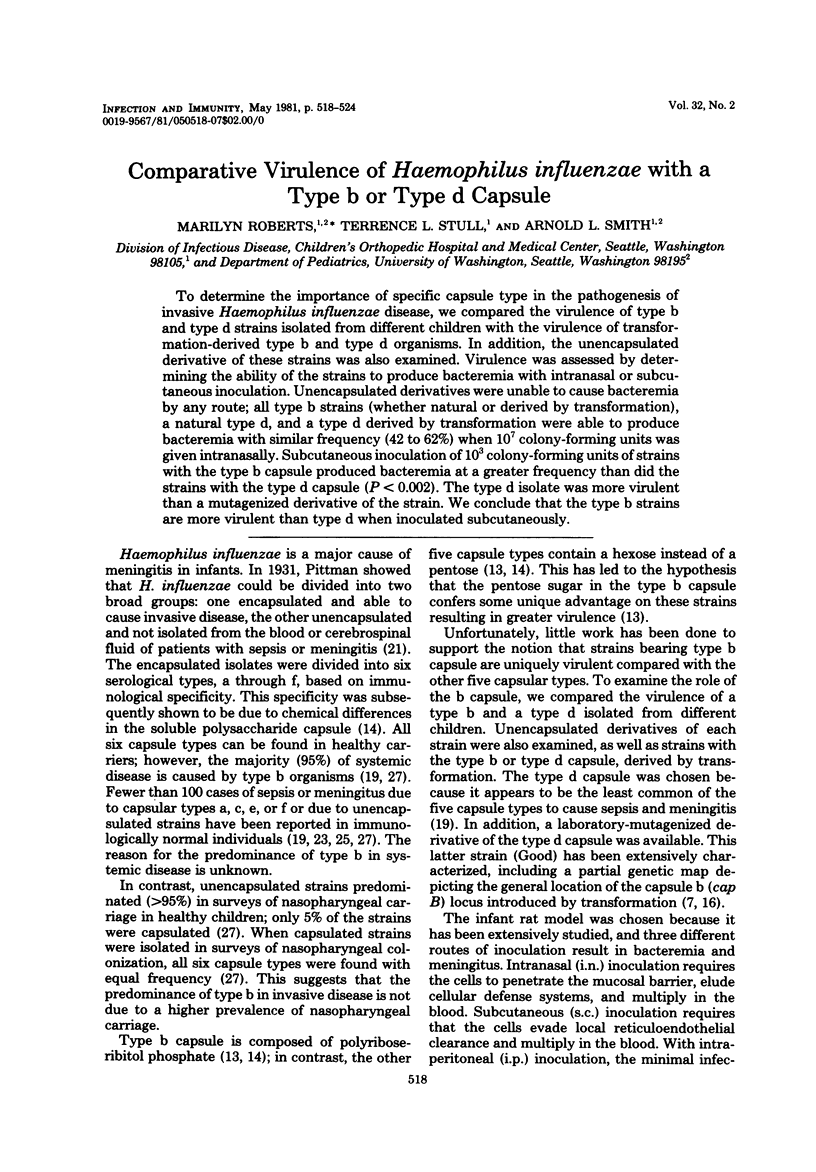
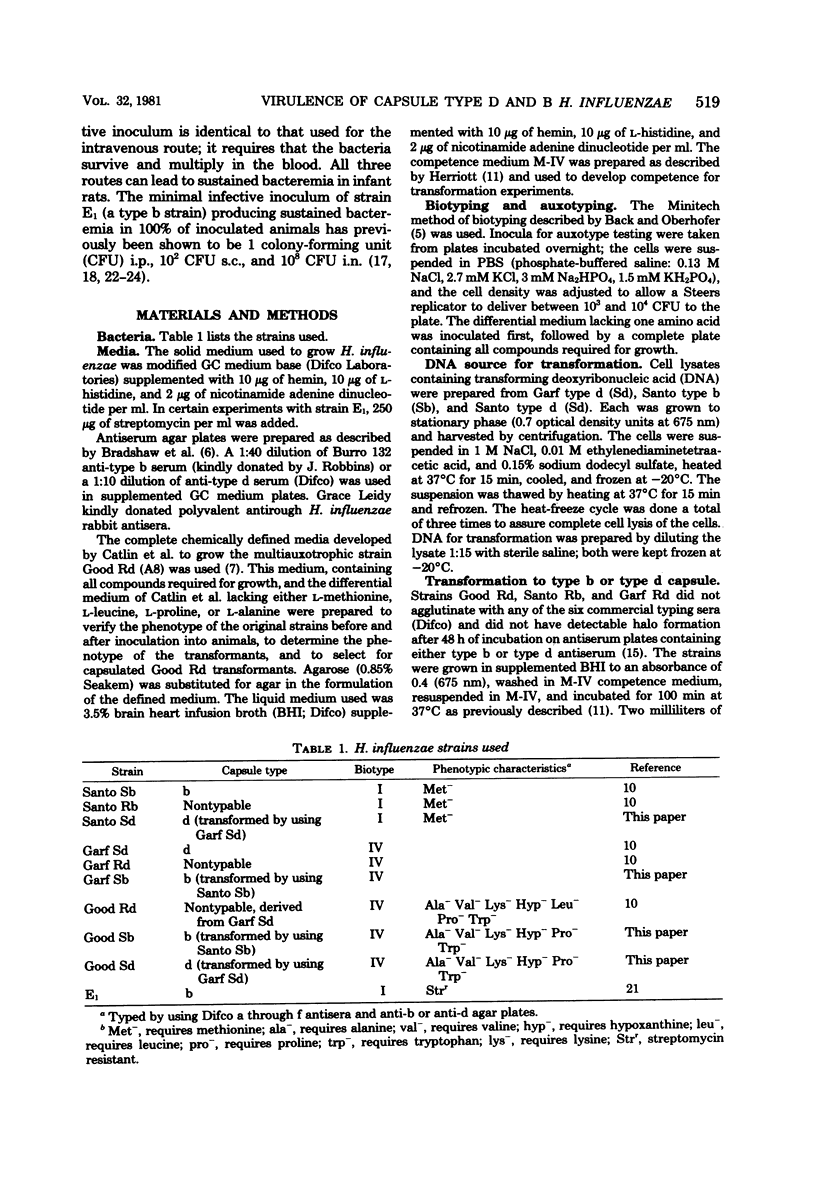
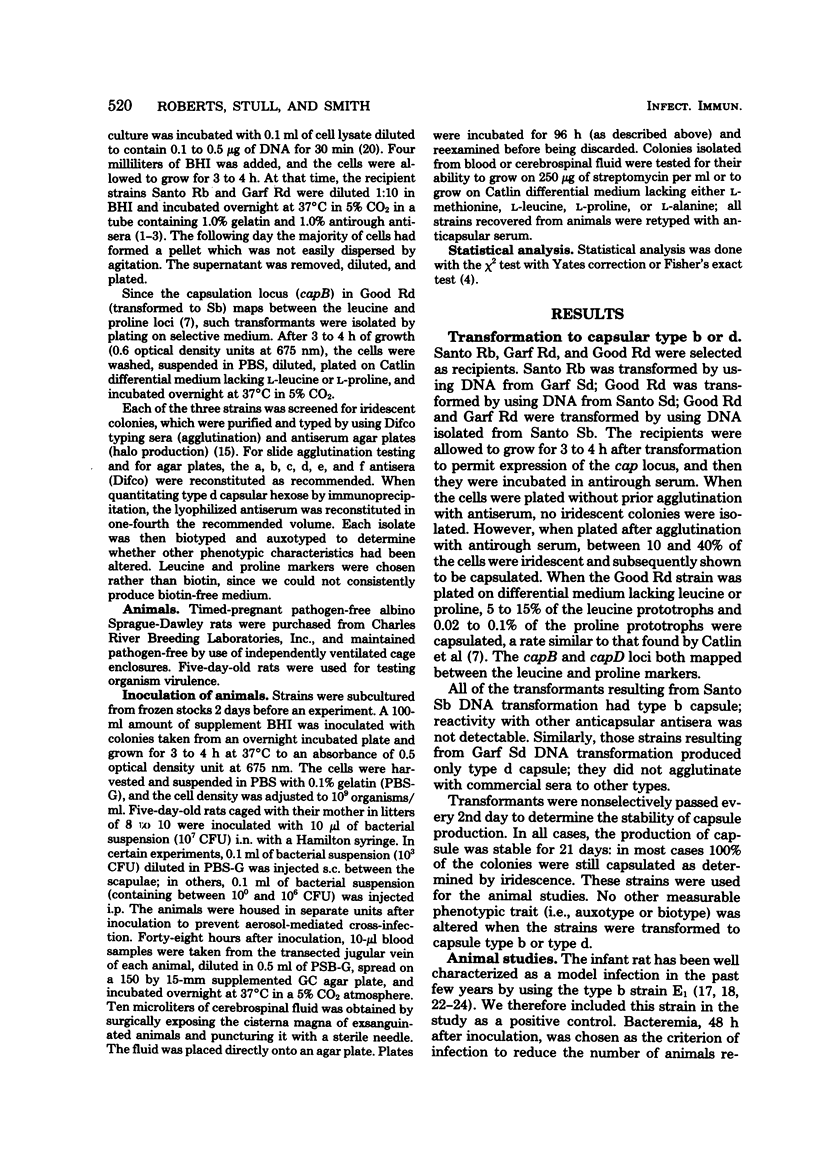
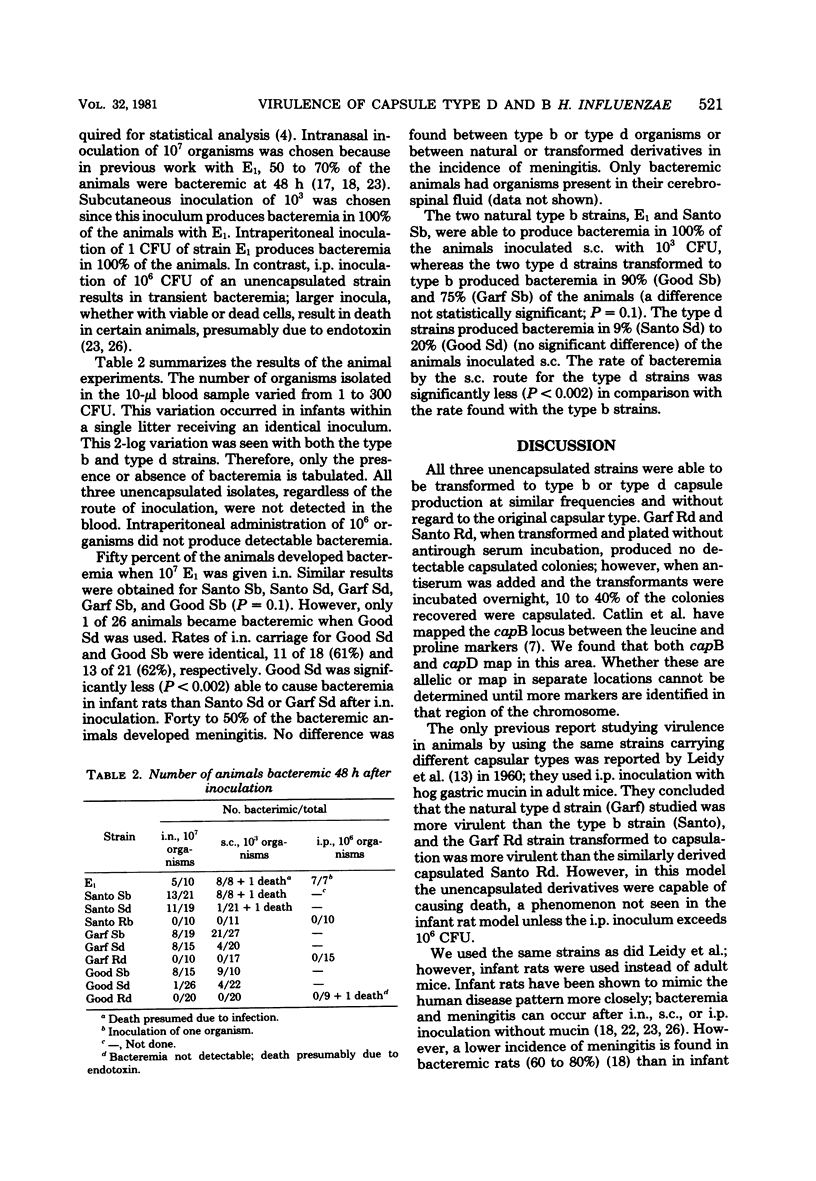
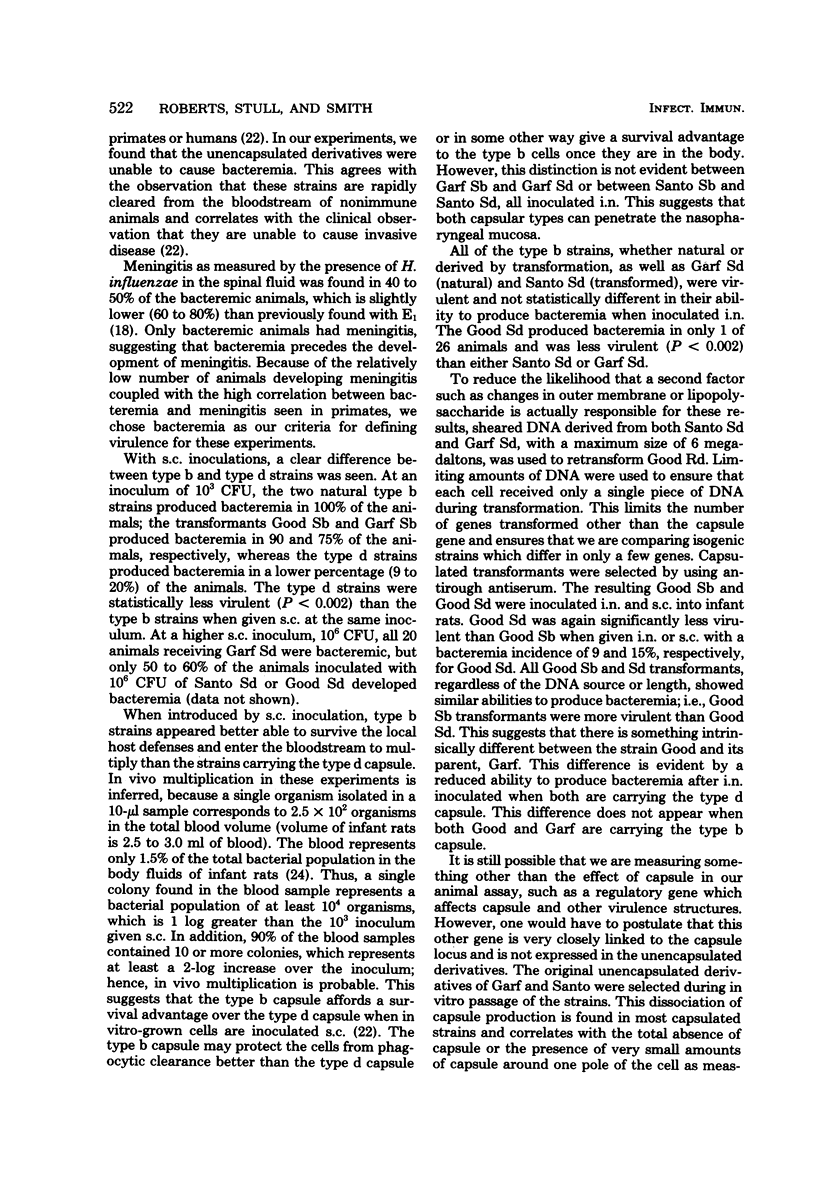
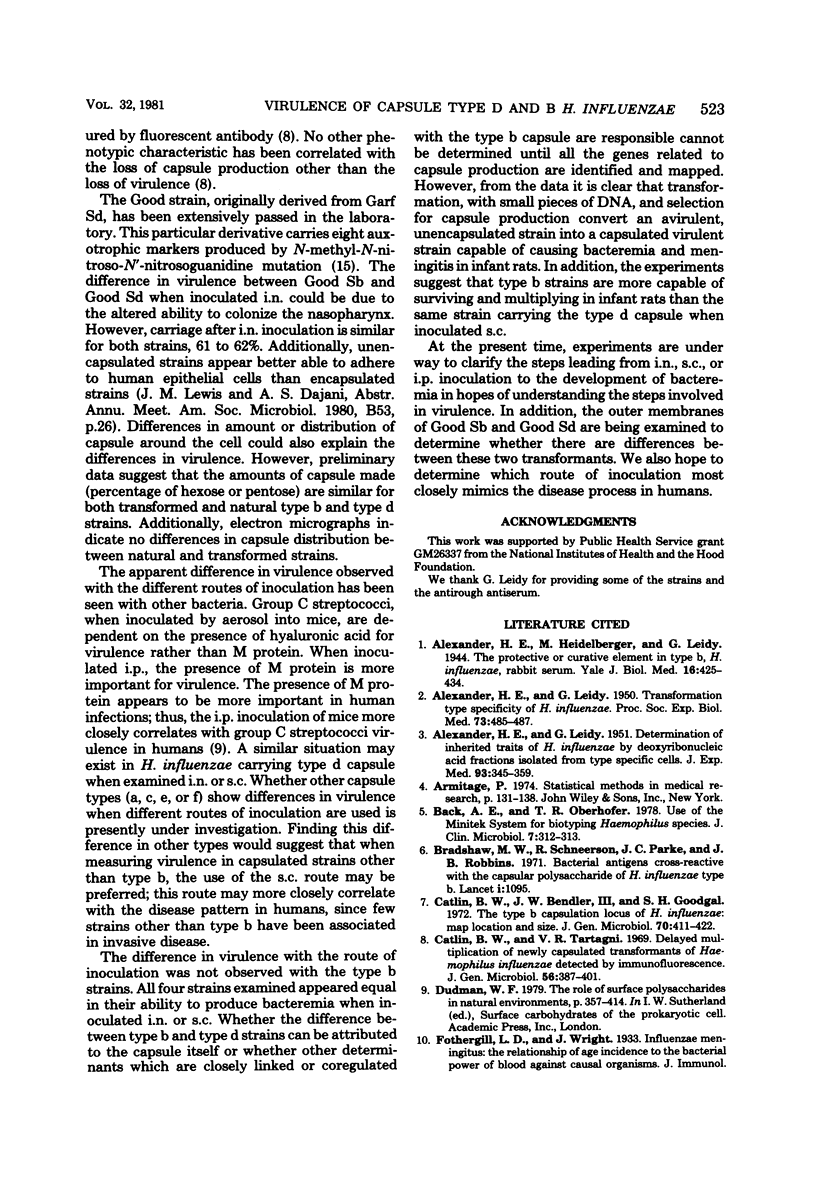
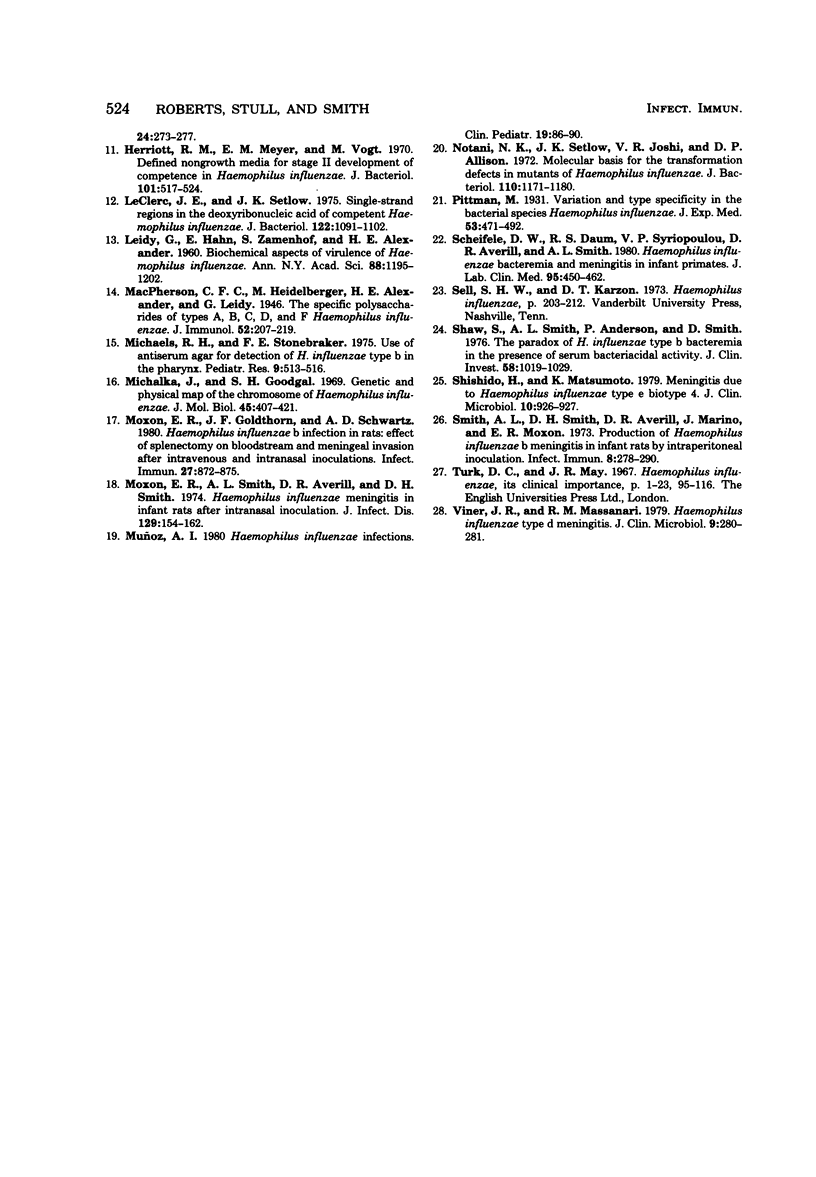
Selected References
These references are in PubMed. This may not be the complete list of references from this article.
- ALEXANDER H. E., LEIDY G. Determination of inherited traits of H. influenzae by desoxyribonucleic acid fractions isolated from type-specific cells. J Exp Med. 1951 Apr 1;93(4):345–359. doi: 10.1084/jem.93.4.345. [DOI] [PMC free article] [PubMed] [Google Scholar]
- Back A. E., Oberhofer T. R. Use of the Minitek system for biotyping Haemophilus species. J Clin Microbiol. 1978 Mar;7(3):312–313. doi: 10.1128/jcm.7.3.312-313.1978. [DOI] [PMC free article] [PubMed] [Google Scholar]
- Bradshaw M. W., Schneerson R., Parke J. C., Jr, Robbins J. B. Bacterial antigens cross-reactive with the capsular polysaccharide of Haemophilus influenzae type b. Lancet. 1971 May 29;1(7709):1095–1096. doi: 10.1016/s0140-6736(71)91837-x. [DOI] [PubMed] [Google Scholar]
- Catlin B. W., Bendler J. W., 3rd, Goodgal S. H. The type b capsulation locus of Haemophilus influenzae: map location and size. J Gen Microbiol. 1972 May;70(3):411–422. doi: 10.1099/00221287-70-3-411. [DOI] [PubMed] [Google Scholar]
- Catlin B. W., Tartagni V. R. Delayed multiplication of newly capsulated transformants of Haemophilus influenzae detected by immunofluorescence. J Gen Microbiol. 1969 Jun;56(3):387–401. doi: 10.1099/00221287-56-3-387. [DOI] [PubMed] [Google Scholar]
- Herriott R. M., Meyer E. M., Vogt M. Defined nongrowth media for stage II development of competence in Haemophilus influenzae. J Bacteriol. 1970 Feb;101(2):517–524. doi: 10.1128/jb.101.2.517-524.1970. [DOI] [PMC free article] [PubMed] [Google Scholar]
- LEIDY G., HAHN E., ZAMENHOF S., ALEXANDER H. E. Biochemical aspects of virulence of Hemophilus influenzae. Ann N Y Acad Sci. 1960 Nov 21;88:1195–1202. doi: 10.1111/j.1749-6632.1960.tb20109.x. [DOI] [PubMed] [Google Scholar]
- LeClerc J. E., Setlow J. K. Single-strand regions in the deoxyribonucleic acid of competent Haemophilus influenzae. J Bacteriol. 1975 Jun;122(3):1091–1102. doi: 10.1128/jb.122.3.1091-1102.1975. [DOI] [PMC free article] [PubMed] [Google Scholar]
- Michaels R. H., Stonebraker F. E., Robbins J. B. Use of antiserum agar for detection of Haemophilus influenzae type b in the pharynx. Pediatr Res. 1975 May;9(5):513–516. doi: 10.1203/00006450-197505000-00010. [DOI] [PubMed] [Google Scholar]
- Michalka J., Goodgal S. H. Genetic and physical map of the chromosome of Hemophilus influenzae. J Mol Biol. 1969 Oct 28;45(2):407–421. doi: 10.1016/0022-2836(69)90115-6. [DOI] [PubMed] [Google Scholar]
- Moxon E. R., Goldthorn J. F., Schwartz A. D. Haemophilus influenzae b infection in rats: effect of splenectomy on bloodstream and meningeal invasion after intravenous and intranasal inoculations. Infect Immun. 1980 Mar;27(3):872–875. doi: 10.1128/iai.27.3.872-875.1980. [DOI] [PMC free article] [PubMed] [Google Scholar]
- Moxon E. R., Smith A. L., Averill D. R., Smith D. H. Haemophilus influenzae meningitis in infant rats after intranasal inoculation. J Infect Dis. 1974 Feb;129(2):154–162. doi: 10.1093/infdis/129.2.154. [DOI] [PubMed] [Google Scholar]
- Notani N. K., Setlow J. K., Joshi V. R., Allison D. P. Molecular basis for the transformation defects in mutants of Haemophilus influenzae. J Bacteriol. 1972 Jun;110(3):1171–1180. doi: 10.1128/jb.110.3.1171-1180.1972. [DOI] [PMC free article] [PubMed] [Google Scholar]
- Scheifele D. W., Daum R. S., Syriopoulou V. P., Averill D. R., Smith A. L. Haemophilus influenzae bacteremia and meningitis in infant primates. J Lab Clin Med. 1980 Mar;95(3):450–462. [PubMed] [Google Scholar]
- Shaw S., Smith A. L., Anderson P., Smith D. H. The paradox of Hemophilus infuenzae type B bacteremia in the presence of serum bactericidal activity. J Clin Invest. 1976 Oct;58(4):1019–1029. doi: 10.1172/JCI108525. [DOI] [PMC free article] [PubMed] [Google Scholar]
- Shishido H., Matsumoto K. Meningitis due to Haemophilus influenzae type e biotype 4. J Clin Microbiol. 1979 Dec;10(6):926–927. doi: 10.1128/jcm.10.6.926-927.1979. [DOI] [PMC free article] [PubMed] [Google Scholar]
- Smith A. L., Smith D. H., Averill D. R., Jr, Marino J., Moxon E. R. Production of Haemophilus influenzae b meningitis in infant rats by intraperitoneal inoculation. Infect Immun. 1973 Aug;8(2):278–290. doi: 10.1128/iai.8.2.278-290.1973. [DOI] [PMC free article] [PubMed] [Google Scholar]
- Viner J. P., Massanari R. M. Haemophilus influenzae Type D meningitis. J Clin Microbiol. 1979 Feb;9(2):280–281. doi: 10.1128/jcm.9.2.280-281.1979. [DOI] [PMC free article] [PubMed] [Google Scholar]


